Dornier 328
| Dornier 328 | |
|---|---|
 A Dornier 328 of Sun-Air of Scandinavia, painted in British Airways livery | |
| General information | |
| Type | Airliner |
| National origin | Germany |
| Manufacturer | Dornier, Fairchild-Dornier Sierra Nevada Corporation Deutsche Aircraft |
| Status | In service |
| Primary users | Central Mountain Air |
| Number built | 217 |
| History | |
| Manufactured | 1991–2000 2020-present |
| Introduction date | October 1993 |
| First flight | 6 December 1991 |
| Developed into | Fairchild Dornier 328JET D328eco |
The Dornier 328 is a turboprop-powered commuter airliner. Initially produced by Dornier Luftfahrt GmbH, the firm was acquired in 1996 by Fairchild Aircraft. The resulting firm, named Fairchild-Dornier, manufactured the 328 family in Oberpfaffenhofen, Germany, conducted sales from San Antonio, Texas, United States, and supported the product line from both locations. A jet-powered version of the aircraft, the Fairchild Dornier 328JET, was also produced.
Development
[edit]Origins
[edit]The Dornier 328 program started when Dornier was still owned by Deutsche Aerospace. Feedback from 1984 market research indicated a desire for a fast, quiet, and easy-to-maintain commuter airliner with a 30-seat capacity.[1] Sales were projected to reach at least 400 units.[2] Favorable features included a high cruising speed of 345 kt (640 km/h), and a higher cruising altitude and range, making the aircraft almost as fast as jet airliners while being more fuel-efficient. A trend away from spoke–and-hub distribution in favor of point-to-point transit was also viewed as being favorable to the 328.[3]
In December 1988, the 328 project was relaunched following the granting of shareholder approval after negotiations between the Dornier family and Daimler Benz.[1][4] As the result of a six-month evaluation, a selection of powerplants deemed to be appropriate for the 328 was formed, these being the General Electric CT7-9D, the Garrett TPE-341-21, and the Pratt & Whitney Canada PW119A. While the Garrett engine was viewed by Deutsche Aerospace as being technically superior, Pratt & Whitney's powerplant was more advanced in development, thus was chosen.[5] The engine selection was soon followed by the selection of a six-bladed composite propeller from Hartzell, Hartzell's submission being reportedly substantially lighter than competing bids from Dowty and Hamilton Standard.[5] Following various considerations between electromechanical and digital instrumentation, Dornier opted for a digital glass cockpit and selected Honeywell to provide this after considering options from Saab Group, Rockwell Collins, and Smiths Aerospace.[6]
In May 1991, Horizon Air, a US-based airline, placed an order for 35 aircraft; this was the largest order for the 328 at that point and was larger than any other order for it or its competitors to be placed that year.[4] In October 1991, the first prototype of the 328 was formally rolled out.[7] On 6 December 1991, the first prototype conducted the type's maiden flight.[8] On 4 June 1992, a second 328 prototype performed its first flight.[9] On 14 December 1992, one of the 328 prototypes suffered a near-catastrophic in-flight propeller failure when all six propeller blades on one engine detached before puncturing the fuselage; the subsequent temporary loss of control caused the aircraft to roll 280° and descend 5,000 feet (1,500 m) before control was recovered.[10]
On 13 October 1993, the 328 formally entered commercial service.[11][12] The 328 was launched into the market during a period of large numbers of competing turboprop aircraft, as well as increasing competition from newly launched regional jets, which were becoming increasingly popular during the early 1990s.[13][14][15] The 328 had the advantages of being both quieter and faster than many of its rivals, but this did not ensure its commercial success.[13] The latter half of the 328 program took place during a recession, which curtailed demand for new aircraft from operators.[4] Both the 328 and the wider Dornier division of Deutsche Aerospace proved to be losing money; accordingly, Deutsche Aerospace wavered in committing more resources to the regional aircraft market, repeatedly delaying a decision to proceed with a 48-seat stretched model of the 328, which had originally been unveiled in 1991.[16][17][18]
Further development
[edit]During the early 1990s, Deutsche Aerospace and Fokker explored the prospects of a commercial relationship to mutually engage the regional aircraft market;[14] this culminated in Deutsche Aerospace purchasing a 40% stake in Fokker in 1993.[19] In June 1995, Deutsche Aerospace and Daewoo Heavy Industries were reportedly conducting talks on the establishment of a second 328 assembly line in South Korea for the Asian market.[20] In 1995, both Fokker and Deutsche Aerospace suffered substantial financial difficulties, which ultimately led to the end of the latter's ambitions to dominate the European regional aircraft market.[21][19] In June 1996, Deutsche Aerospace sold the majority of Dornier Luftfahrt GmbH to American manufacturer Fairchild Aircraft, leading to the creation of Fairchild Dornier GmbH.[13] The newly combined Fairchild Dornier company emerged as the third-largest regional aircraft manufacturer in the world, and viewed the 328 as being both a key product in its lineup and the basis for a future family of aircraft.[13]
Continuing development of a jet-powered variant of the 328 was initially designated as the Dornier 328-300 and later simply known as the Dornier 328JET, which had been started under Deutsche Aerospace. Fairchild Dornier also sought to develop a stretched version, designated as the Dornier 428JET, and a dedicated freighter model.[13][22][23] Additionally, Farchild Dornier developed a larger aircraft, the Fairchild Dornier 728 family. In addition to typical passenger models, business jet configurations of both the 728JET and 928JET were projected, tentatively referred to as Envoy 3 and Envoy 7, respectively.[13] The ambitious family project drew the support of the German government, which guaranteed US$350 million in loans for the scheme.[13] During the late 1990s, Fairchild Dornier struggled to find both capital and strategic partners to support the project, and the company entered bankruptcy in April 2002.[13]
Dornier aftermath
[edit]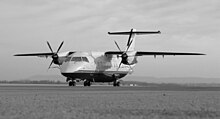
Following the bankruptcy of Fairchild Dornier, AvCraft Aviation acquired the Dornier 328/328JET rights, but this company entered bankruptcy less than three years later.[24][25] In June 2006, 328 Support Services GmbH acquired the type certificate for the Dornier 328.[26] It provides maintenance, repair, and overhaul services to the existing in-service fleet.[27]
In February 2015, US engineering company Sierra Nevada Corporation acquired 328 Support Services GmbH.[28][24] Shortly thereafter, Sierra Nevada's owner, Turkish-American engineer Fatih Ozmen established a private corporation named Özjet Havacılık Teknolojileri A.Ş. at Technopark of Bilkent University, Ankara, and signed a memorandum of understanding with the Transportation Ministry of Turkey to manufacture the 328 at Ankara.[29] In June 2015, the Turkish government launched the Turkish TR328 and TRJ328 regional aircraft project, a modernized 328/328JET, with either turboprops or jets for civil and military use [30] and a larger TR628/TRJ-628[31] forecasting a break-even level and market of 500–1000 for each type.
First flight was anticipated in 2019, but Turkey abandoned the program in October 2017, after facing increasing costs and no longer being confident of market demand forecasts. Believing in the under 40-seat market, Sierra Nevada Corporation and 328 Support Services GmbH are searching for other means to revive the aircraft, hoping to follow through by the end of 2017 or early 2018.[32][needs update]
Existing aircraft can be sourced by 328 Support Services and converted for civil transport, military operations, medical evacuation, or freighter or utility missions for $7–9 million, including zero time turboprops. Sierra Nevada Corp. plans to build a new stretched 328 in Germany.[33]
D328eco
[edit]On 21 August 2019, 328 Support Services announced the formation of DRA GmbH to establish its final assembly line for the D328NEU at Leipzig/Halle Airport, creating of up to 250 new jobs there and over 100 jobs in Oberpfaffenhofen, near Munich; the programme should be detailed late in the first quarter of 2020.[34] The company signed a memorandum of understanding with the federal authorities of Germany, and State of Saxony ministries.[35] To revive the turboprop design, SNC was set to invest €80 million ($88.75 million) in DRA while the state of Saxony pledged €6.5 million.[36] On 29 April 2020, DRA GmbH rebranded its proposed D328NEU as the "D328eco".[37] DRA GmbH was not able to use the Dornier name as the trademark belongs to Airbus and is used by its subsidiary Dornier Consulting. Instead, DRA GmbH created a new brand, Deutsche Aircraft.[38][39]
The redesigned aircraft is stretched by 2 m (6 ft 7 in) to 23.3 m (76.4 ft), permitting it to carry up to 43 passengers, 10 more than the original Dornier 328.[40] The adoption of advanced avionics, such as the Garmin G5000 avionics suite, may permit single-pilot operations under some circumstances.[40][41] It will be powered by Pratt & Whitney Canada PW127XT-S; the engine output increases from 2,180 to 2,750 hp (1,630 to 2,050 kW) with 2-3% better brake specific fuel consumption, and maximum take-off weight is increased by 1.7 to 15.6 t (3,700 to 34,400 lb), similar to the 328JET.[42] The company has targeted a 600 km/h / 324 kn speed, a 9,144 m / 30,000 ft altitude, operations from 1,000 m (3,300 ft) runways, and a fuel consumption of 2.6 L/100 km (90 mpg‑US) each for 43 passengers; its length would be 23.31 m (76.5 ft) and its wingspan 20.98 m (68.8 ft)[39]
In January 2021, it was reported that the first flight was scheduled to take place during 2024, while Supplemental type certification and service entry were both planned for 2025; the production facility has been sized to accommodate up to 48 aircraft per year.[42][38] During June 2023, the company announced that it has commenced the fabrication of the first prototype aircraft.[43]
Design
[edit]
The Dornier 328 is a twin-turboprop engined, regional aircraft, principally designed for short-haul passenger operators; Deutsche Aerospace often promoted the type as being a "third-generation airliner".[1] The fuselage of the 328 employs an unusual streamlined shape, having been optimised for high cruising speeds; the aircraft is capable of higher cruise and approach speeds than most turboprop-powered aircraft, which allows it to be more readily slotted around jetliners during landing approaches.[44] According to Deutsche Aerospace, the 328 offered the "lowest noise level, widest cabin, highest standing room, widest cabin floor, and widest seats in the three-abreast class".[45] The 328 is capable of operations from semi-prepared airstrips and rough runways, incorporating features such as its retractable landing gear being equipped with high-flotation tyres and steerable nose gear and a gravel guard.[46]
It is equipped with a pair of Pratt and Whitney PW119C turboprop engines, which drive fully reversible Hartzell HD-E6C-3B propellers.[46] The propeller blades generate notably less noise in comparison to their contemporary counterparts due to features such as their lower rotation speed,[47][4] propeller synchrophasing, and the use of a six-blade configuration.[5] The propeller system is variable-pitch to maintain a constant engine speed.[5] During the early 1990s, the manufacturer claimed that the use of various noise-reduction measures across the aircraft kept the internal cabin noise "below that of even some modern jet aircraft".[7]
The fuselage of 328 allows for a comfortable three-abreast, airline-style seating arrangement to be used, as well as a dense, four-abreast configuration to accommodate greater passenger numbers, of which it is able to carry a maximum of 27.[46] A total of six cabin configurations is available for passenger and cargo operations; these include a flexible combi aircraft layout with a movable wall separating passengers and cargo, and a medical evacuation arrangement equipped with biofloors and positions for four litters and medical attendees.[46] The 328 is pressurized, a first for Dornier-built aircraft, which was implemented to achieve a higher level of passenger comfort; the passenger cabin is designed to be more akin to those of much larger passenger aircraft.[44] A full-sized galley, toilet, and washbasin can also be installed.[1]
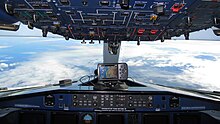
The 328 is furnished with the same supercritical wing design that had been originally developed for Dornier's earlier Dornier 228; this wing provides the aircraft with both excellent cruise and climb capabilities.[47][4] The straightforward construction techniques of the Dornier 228 were also reused for the 328, despite making increased use of composite materials in areas such as the rear fuselage and empennage. The 328 reportedly made greater use of composites than any of its direct competitors at launch; the use of the Kevlar-carbon fiber composites is claimed to have reduced its weight by 20%.[47][48] Various materials are used across the airframe; amongst these, an aluminium alloy is used for the pressure fuselage and much of the wingbox, a titanium alloy for the tail cone, and glass fibre-reinforced plastic for the radome and leading edge of the vertical stabilizer.[49] Noise-absorbent material is located across the fuselage, while the cabin wall is hung from isolator brackets to reduce vibration and noise transference.[47][48]
The twin-crew glass cockpit of the 328 is equipped with a Honeywell Primus 2000 avionics suite, and the cockpit has an electronic flight instrument system comprising five 20 x 17.5 cm cathode ray tube (CRT) monitors.[46] The central CRT serves as the engine-indicating and crew-alerting system, while the two inner CRTs are used as multifunctional displays and the outermost two CRTs perform as the primary flight displays.[49] Addition avionics include a dual integrated avionics computer, a digital databus (a commercial derivative of the MIL-STD-1553 databus), dual Primus II integrated radio system, automatic flight control system, dual digital air data reference units, Primus 650 weather radar, dual mode-S transponder, enhanced ground proximity warning system, and traffic collision avoidance system.[46][47][50]
Operational history
[edit]This section needs expansion. You can help by adding to it. (July 2016) |
In 2005, the Australian Maritime Safety Authority awarded a contract to AeroRescue to provide long-range search and rescue capability around Australia. Accordingly, five 328-100s were progressively commissioned from April 2006 [51] to February 2007 and stationed around the Australian coastline to provide a 24-hour, 30-minute response capability. These aircraft were equipped with a comprehensive electronic sensor suite by Aerodata AG in Germany including; Israel Aerospace Industries ELTA EL/M 2022A Radar, FSI Star SAFire III Forward Looking Infra Red, Direction Finder and an ARGON ST Infra Red/Ultra Violet scanner. The aircraft are also fitted with an Aeronautical Engineers Australia dispatch system, allowing rescue stores to be dropped from the aircraft through a chute through the underwing emergency exit. These are progressively being upgraded with an in-flight-opening cargo door to allow dispatch of larger items, up to 20-person life rafts, and boat-dewatering pumps for open-water rescues. These aircraft were replaced by a fleet of CL604 jets under contract to AMSA.[52]
Variants
[edit]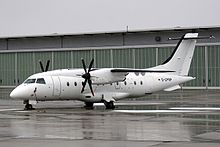
- 328-100 – Initial 328.
- 328-110 – Standard 328 with greater range and weights
- 328-120 – 328 with improved STOL performance
- 328-130 – 328 with progressive rudder authority reduction at higher airspeeds
- 328JET – turbofan-powered variant, formerly the 328-300
- C-146A Wolfhound – designation assigned to 20 Dornier 328s operated by the United States Air Force's Air Force Special Operations Command.[53][54]
- Deutsche Aircraft D328eco - new production in Leipzig, announced in August 2019.[34]
Operators
[edit]In July 2018, 24 aircraft were in airline service. Major operators include Private Wings (9) and DANA (4). Seven other airlines operate smaller numbers of the type.[55] By 2018, 328 Support Services supported 200 turboprops and jets.[33] By August 2019, 58 turboprops and 50 jets were in service, with the largest operators being the US Air Force (20 units), Danish carrier Sun-Air (12), German- Private Wings (10), and American Ultimate Jetcharters (8); 19 turboprops and nine jets were in storage, while 79 have been retired.[56]
Military/government
[edit]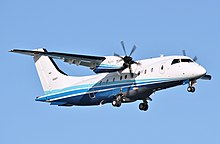
Civilian
[edit]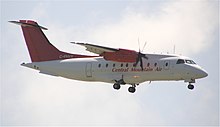
- Rhein-Neckar Air (3)
- Private Wings (9)
- The Dornier 328 turboprop was operated in scheduled passenger service by several U.S. regional airlines how: ACJet Atlantic Coast Jet, Air Wisconsin, Horizon Air, Lone Star Airlines, PSA Airlines US Airways Express and Mountain Air Express.
In addition, the aircraft was previously used to provide passenger feeder services in the U.S. operating as United Express and US Airways Express flights.
Accidents
[edit]- On 25 February 1999, Alitalia Flight 1553, operated by Minerva Airlines, was operating a flight from Cagliari-Elmas Airport to Genoa Cristoforo Colombo Airport in Italy. Upon landing on runway 29, the aircraft ran off the end of the runway and crashed into the sea. Four of the 31 passengers and crew died in the accident.[57]
Specifications (Dornier 328-110)
[edit]
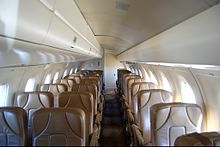
Data from Jane's All the World's Aircraft 1999–2000[58]
General characteristics
- Crew: 3 (2 Pilots, one Flight Attendant)
- Capacity: 30 to 33
- Length: 21.28 m (69 ft 10 in)
- Wingspan: 20.98 m (68 ft 10 in)
- Height: 7.24 m (23 ft 9 in)
- Wing area: 40.00 m2 (430.6 sq ft)
- Aspect ratio: 11.0:1
- Airfoil: Do A-5 [59]
- Empty weight: 8,920 kg (19,665 lb)
- Max takeoff weight: 13,990 kg (30,843 lb)
- Fuel capacity: 4,268 L (1,127 US gal; 939 imp gal)
- Powerplant: 2 × Pratt & Whitney Canada PW119B turboprop engines, 1,625 kW (2,179 hp) each
- Propellers: 6-bladed Hartzell, 3.60 m (11 ft 10 in) diameter
Performance
- Cruise speed: 620 km/h (390 mph, 330 kn) at 6,100 m (20,000 ft)
- Range: 1,852 km (1,151 mi, 1,000 nmi) at 9,450 m (31,000 ft) (reserves for 190 km (120 mi; 100 nmi) diversion and 45 min hold)
- Service ceiling: 9,492 m (31,100 ft)
Avionics
Honeywell Primus 2000
See also
[edit]| External videos | |
|---|---|
Related development
Aircraft of comparable role, configuration, and era
References
[edit]Citations
[edit]- ^ a b c d Moxon 1991, p. 69.
- ^ Moxon, Barrie and Goold 1991, pp. 31–32.
- ^ Moxon, Barrie and Goold 1991, pp. 32–33.
- ^ a b c d e Moxon, Barrie and Goold 1991, p. 32.
- ^ a b c d Moxon, Barrie and Goold 1991, p. 34.
- ^ Moxon, Barrie and Goold 1991, p. 38.
- ^ a b Moxon, Barrie and Goold 1991, p. 31.
- ^ Swanborough 1992, p. 123.
- ^ "Second Dornier 328 Joins Test Programme." Flight International, 23 June 1992. p. 9.
- ^ Barrie, Douglas. "Dornier 328 prototype hit by propeller failure." Flight International, 12 January 1993. p. 4.
- ^ Taylor 1999, p. 195.
- ^ "Premiere: Dornier 328." Flight International, 8 October 1991. p. 28.
- ^ a b c d e f g h "Fairchild Dornier Gmbh Company Profile, Information, Business Description, History, Background Information on Fairchild Dornier Gmbh." Reference for Business, Retrieved: 5 May 2008.
- ^ a b "Decisions, Decisions." Flight International, 2 June 1992. pp. 35, 38.
- ^ "DASA warns of clash in regional launch plans." Flight International, 10 December 1991. p. 6.
- ^ Barrie, Douglas. "Domier details a stretched Do.328." Flight International, 29 October 1991. pp. 4–5.
- ^ "DASA dithers on Dornier 328 stretch." Flight International, 11 May 1993. p. 10.
- ^ "Buyers demand stretched Dornier 328." Flight International, 11 June 1991. p. 5.
- ^ a b Jeziorski, Andrzej. "DASA folds its wings." Flight International, 31 January 1996.
- ^ Jeziorski, Andrzej. "DASA in talks over Korean 328 deal production." Flight International, 14 June 1995.
- ^ Jeziorski, Andrzej. "DASA dealt double blow." Flight International, 23 August 1995.
- ^ "Dornier sets jet date." Flight International, 17 September 1996. p. 9.
- ^ Doyle, Andrew. "Regional Aviation: Joining the Jet Age." Flight International, 28 September 1999.
- ^ a b Dan Thisdell (18 February 2015). "New era for Dornier 328 with Sierra Nevada acquisition". Flight International.
- ^ Kate Sarsfield (27 March 2015). "Back to life: nine civil types revived". Flight International.
- ^ "FAA Type Certificate Data Sheet No. A45NM" (PDF). Federal Aviation Administration. September 9, 2016. Archived from the original (PDF) on May 13, 2021. Retrieved October 21, 2017.
- ^ "328 Support Services GmbH". Sierra Nevada Corporation.
- ^ "Sierra Nevada Corporation Expands into Global Aircraft Markets through Investments in UK and Germany – SNC Acquires 328 Support Services GmbH" (Press release). Sierra Nevada Corporation. February 6, 2015.
- ^ "Sierra Nevada Corporation Collaborates on Regional Jet Aircraft in Turkey" (Press release). Sierra Nevada Corporation. May 27, 2015.
- ^ Dominic Perry (15 June 2015). "PARIS: Turkish regional aircraft may feature P&W engines". Flight International.
- ^ Niall O'Keeffe (15 October 2015). "Programme partner outlines production plan for modernised 328s". Flight International.
- ^ Alan Dron (Oct 20, 2017). "Turkey scraps Dornier 328 revival". Aviation Week Network. Archived from the original on 2017-10-20.
- ^ a b James Wynbrandt (July 17, 2018). "328 Support Highlights Dornier Conversions". AIN online.
- ^ a b "328 Support Services GmbH & Germany Partner to Form Leipzig-based OEM, DRA GmbH" (PDF) (Press release). Sierra Nevada Corporation / 328 Support Services GmbH. 21 August 2019. Archived from the original (PDF) on 21 August 2019. Retrieved 21 August 2019.
- ^ "Dornier's 328 Leipz' into the Next Generation". Airliner World. October 2019: 17.
- ^ Buyck, Cathy (21 August 2019). "New OEM in Germany To Build Upgrade of the Dornier 328". AIN Online.
- ^ "DRA – Deutsche Regional Aircraft GmbH Q1 2020 Update – Appointment of Chief Technology Officer Martin Nüsseler". 328 Support Services GmbH. Archived from the original on 2021-02-09. Retrieved 2021-06-01.
- ^ a b "Wir glauben, dass unser Flugzeug besser ist als die ATR 42" [«We believe that our aircraft is better than the ATR 42»]. aerotelegraph.com (in German). 1 February 2021. Retrieved 4 February 2021.
- ^ a b "Products". Deutsche Aircraft. Archived from the original on 2021-06-03. Retrieved 2020-12-07.
- ^ a b Hemmerdinger, Jon (8 December 2020). "Germany's D328eco will have longer fuselage, single-pilot technology". Flightglobal.
- ^ "Deutsche Aircraft selects Garmin G5000 avionics suite for its new D328eco aircraft". Deutsche Aircraft.
- ^ a b Perry, Dominic (8 January 2021). "How Deutsche Aircraft plans to tackle regional resurgence with reborn Dornier 328". Flightglobal.
- ^ Perry, Dominic (21 June 2023). "First metal cut for D328eco, with supply chain 90% 'locked down'". Flightglobal. Retrieved 22 June 2023.
- ^ a b Moxon 1991, pp. 69–70.
- ^ Moxon, Barrie and Goold 1991, p. 40.
- ^ a b c d e f "Dornier-328-100." Archived 2019-08-05 at the Wayback Machine Sierra Nevada Corporation, 2014.
- ^ a b c d e Moxon 1991, p. 70.
- ^ a b Moxon, Barrie and Goold 1991, p. 39.
- ^ a b Moxon, Barrie and Goold 1991, pp. 38–39.
- ^ Moxon, Barrie and Goold 1991, pp. 36, 39.
- ^ "Search and Rescue" (PDF). Australian Maritime Safety Authority. Archived from the original (PDF) on 19 March 2017. Retrieved 23 August 2017.
- ^ "AMSA SAR". Amsa.gov.au. Retrieved 2022-04-26.
- ^ a b "C-146A Wolfhound". United States Air Force. December 13, 2013. Retrieved 2014-08-02.
- ^ "C-146A Wolfhound". 919th Special Operations Wing. 13 December 2013. Archived from the original on 16 November 2018. Retrieved 29 January 2020.
- ^ a b c "World Airline Census 2018". Flightglobal.com. Retrieved 2018-08-26.
- ^ Michael Gubisch (15 Aug 2019). "Sierra Nevada to restart Dornier 328 production in Germany". Flightglobal.
- ^ Harro Ranter (25 February 1999). "ASN Aircraft accident Dornier 328-110 D-CPRR Genoa-Cristoforo Colombo Airport (GOA)". aviation-safety.net. Retrieved 3 July 2015.
- ^ Jackson 1999, pp. 145–146
- ^ Lednicer, David. "The Incomplete Guide to Airfoil Usage". m-selig.ae.illinois.edu. Retrieved 16 April 2019.
Bibliography
[edit]- Jackson, Paul (editor). Jane's All the World's Aircraft 1999–2000. Coulsdon, UK: Jane's Information Group, 1999. ISBN 0-7106-1898-0
- Moxon, Julian. "High Tech Commuter." Flight International, 4 June 1991. pp. 69–70.
- Moxon, Julian., Douglas Barrie and Ian Goold. "Do.328 Described: Friendly, Fast, and Frugal." Flight International, 15 October 1991. pp. 31–40.
- Swanborough, Gordon. "Dornier 328: A Daimler for Commuters". Air International, March 1992, Vol. 42 No. 3. pp. 123–128. ISSN 0306-5634.
- Taylor, Michael J.H. Brassey's World Aircraft & Systems Directory 1999/2000. London:Brassey's, 1999. ISBN 1-85753-245-7.
External links
[edit]- TRJet-Turkish regional aircraft project official page (archived)
- 328 Support Services GmbH official page
- Fred George (Jul 26, 2016). "Used Aircraft Report: Dornier 328 Turboprop". Business & Commercial Aviation. aviation week.
